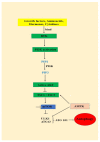Autophagy-A Hidden but Important Actor on Oral Cancer Scene
- PMID: 33297472
- PMCID: PMC7729760
- DOI: 10.3390/ijms21239325
Autophagy-A Hidden but Important Actor on Oral Cancer Scene
Abstract
The duration of denture use, oral hygiene, smoking and male sex were identified as risk factors for oral mucosal lesions. As it is well known, all the oral mucosal lesions associated with risk factors have an important degree of malignity. Chronic mechanical irritation can be another cause of oral cancer and it is produced by the constant action of a deleterious agent from the oral cavity. Autophagy represents a complex evolutionary conserved catabolic process in which cells self-digest intracellular organelles in order to regulate their normal turnover and remove the damaged ones with compromised function to further maintain homeostasis. Autophagy is modulated by mTOR kinase and indirectly by PI3K/AKT survival pathway. Due to its dual capacity to either induce cell death or promote cell survival, important evidence pointed that autophagy has a two-faced role in response to chemotherapy in cancer. In conclusion, understanding how to overcome cytoprotective autophagy and how to take advantage of autophagic cell death is critical in order to enhance the cancer cells sensitivity to particular therapeutic agents.
Keywords: PI3K/AKT/mTOR signaling pathway; autophagy; oral cancer.
Conflict of interest statement
The authors declare no conflict of interest.
Figures


References
Publication types
MeSH terms
Substances
LinkOut - more resources
Full Text Sources
Medical
Research Materials
Miscellaneous

